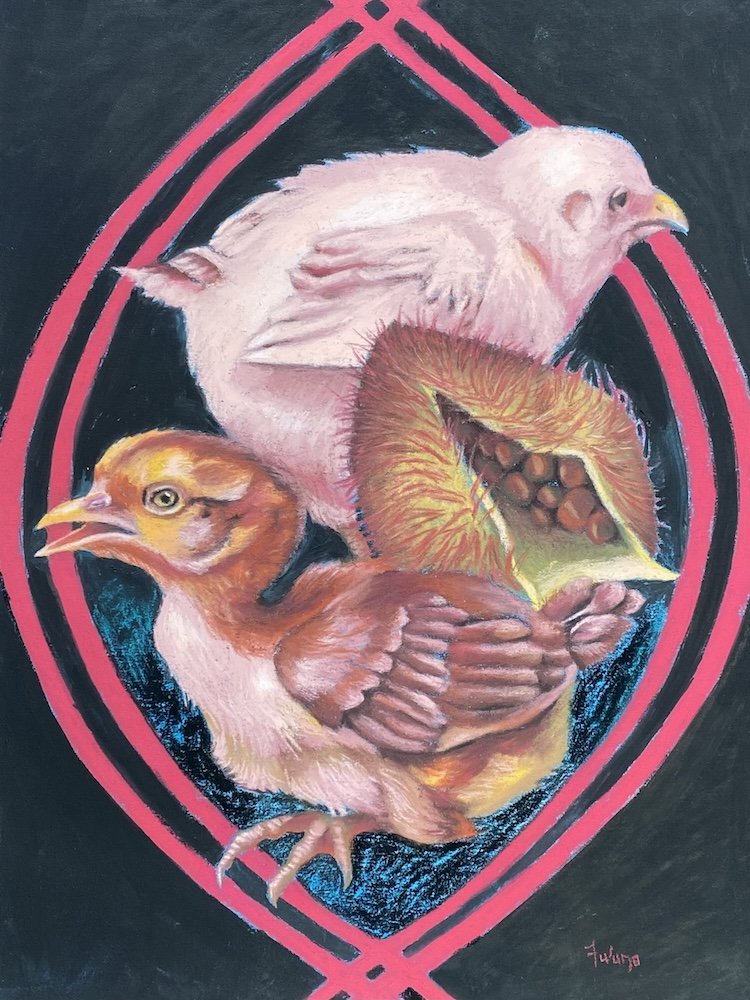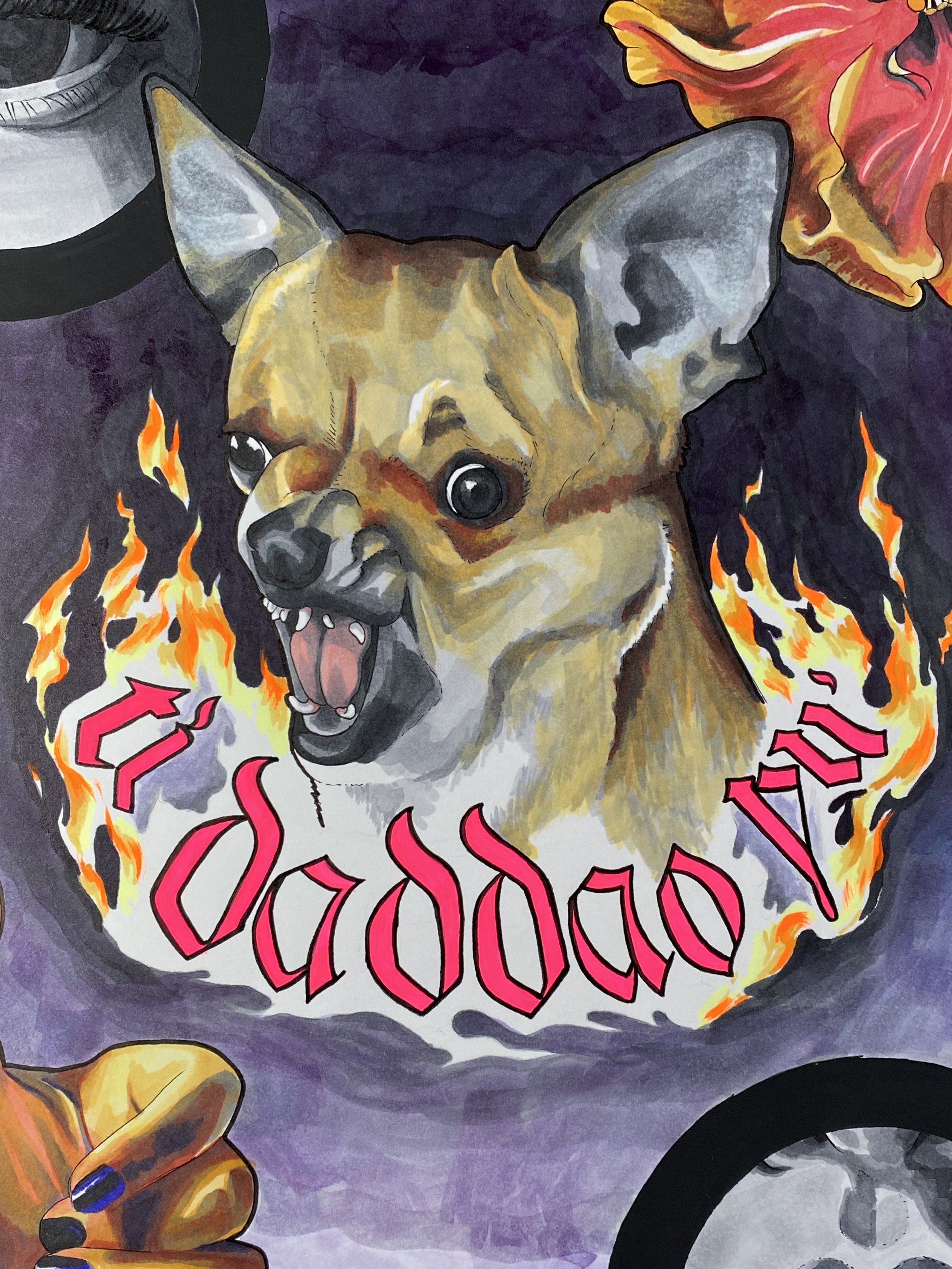052: Fu’una
Based in Rhode Island, Fu’una is a talented Chamoru painter and muralist whose work often captures the spirit of place and identity.
Fu’una
Fu’una specializes in portraits and animal subjects. Her vibrant creations reflect her deep connection to the locations she works in, combining research-driven themes with spontaneous inspiration. Whether crafting public murals or personal pieces, Fu’una’s art is a visual dialogue between her environment and her vivid imagination.
Fu’una
When asked about the essence of art, she defines it as any creative means of expressing oneself and sharing one’s experience of the world. As an introvert and a highly visual person, she was naturally drawn to visual arts, turning a personal passion into a professional journey. Her process is far from linear, often involving years of gestation before she brings an idea to life. Though it can be fraught with self-doubt, Fu’una’s persistence transforms challenges into masterpieces.
Her art is deeply rooted in place-based themes. Research plays a significant role in her creative process, especially for public art projects tied to specific locations. She also finds inspiration in galleries, museums, and social media, but often it’s the unexpected—a fleeting moment or unrelated experience—that sparks her creativity. Her open-minded approach allows her to embrace spontaneity, infusing her work with dynamic energy and originality.
Fu’una
Her approach to color serves as a signature element of her art. Bold and vibrant, her palette is dominated by shades of pink, orange, purple, and black. These colors, which appear frequently in her work, convey both intensity and harmony, setting her creations apart.
Balancing her art with a full-time job is one of her greatest challenges. Working in small, makeshift studio spaces while managing socioeconomic constraints requires a tenacity that defines her journey. Despite these hurdles, she has developed a consistent body of work, which has been instrumental in her growth as an artist. From solo exhibitions to grant projects, each endeavor pushes her toward creating cohesive and evolving pieces.
Fu’una
She acknowledges that all artists share a compulsion to bring ideas to life. This intrinsic drive, she believes, is what keeps artists creating, despite obstacles. Over time, her work has shifted from one-off projects to thematically consistent collections, reflecting her professional growth and commitment to her craft.
For Fu’una, connecting with the Pacific Islander diaspora holds special significance. While her public works are often designed for specific audiences tied to each project, her personal pieces aim to resonate with this broader, yet deeply personal community. Her work serves as a bridge, offering a visual connection to culture, identity, and shared experiences.
Fu’una
She emphasizes the importance of perseverance and self-promotion for aspiring artists. “No one is going to discover you,” she advises. “If you want to be a professional artist, you need to put in the work and put yourself out there.” Whether pursuing art as a hobby or a career, she encourages artists to remain authentic and committed. Fu’una also suggests highlighting indigenous voices in projects like this one, ensuring that cultural authenticity is celebrated and appropriation avoided. Through her art, she not only brings vibrant stories to life but also creates a platform for cultural connection and dialogue, inspiring audiences near and far.
“No one is going to discover you. You have to put in the work and put yourself out there.”
Fu’una
Please introduce yourself and describe what you do. (short bio please!)
I na'ån-hu si Fu'una. Sumåsaga yu giya Rhode Island. Taotao Santa Rita si nanå-hu, familian Texas. I am a painter and muralist, focusing mostly on portraits and animal subjects. A lot of my work is place-based.
How would you define art?
Art is any creative means of expressing yourself, or relaying your experience of the world. It can be visual, audio, movement-based, physical, or embodied.
Why did you choose your art form?
I'm a highly visual person, and I'm an introvert. I naturally gravitated to the materiality of visual arts. It started as something I did for pure enjoyment, then I built my life in a way where I could try to make a career out of what I love most.
Where do you get your inspiration?
As a public artist, a lot of my work is place-based, so I do a lot of research when given a theme or a project that exists within a specific location. I get my conceptual ideas from that research. I also get a lot of visual inspiration from galleries, museums, and other artists on Instagram. But sometimes what's most inspiring is the unexpected. Sometimes I'll get an idea from something that has nothing to do with art or history. It's more of an open-mindedness to spontaneity.
What do you do when you're stuck on an artwork or lacking motivation or inspiration?
Sometimes you need to step away from a piece. If you've been working on it too long you'll notice you're starting to make mistakes. For me, my internal voice can get really negative so when I notice I'm starting to spiral, it's time to walk away. Usually when I come back to it I know what to do to get back on track, or I realize it's not as bad as I thought.
What is something that you add to your art as your signature?
My approach to color is probably the closest thing I have to a signature. I'm attracted to vibrant colors. Going through my Instagram feed, you'll notice that I use a lot of pink, orange, purple, and especially black.
Take us through your process for making art.
Usually I'll have an idea, be too busy to get to it for an entire year or even up to ten years. Then I finally try it, it doesn't go how I plan, I start to hate myself, but then I just keep going until it's good. Then I like it for about a week before I'm ashamed by it and want to make the next thing. I wish I had a better answer.
Fu’una
What do you struggle with the most when making art?
The biggest struggle is time and space. I work full time to support myself, and I work 10-20 hours a week on my art business. Probably the majority of people who succeed as artists have a lot of privilege. Then there's those of us who have to worry about bills, rent, and are working in small, ad-hoc studio spaces. It takes a certain tenacity to stay devoted to your art while working within socioeconomic constraints, and competing against people who have endless resources.
What characteristics do you think all artists share?
I often wonder what it is in our brain that makes us this way. We all have this compulsion to get an idea out of us. That's true no matter what your medium is or what approach you take. We have this urge to do something.
How has your artwork evolved over time?
It took a while for me to get my work to a professional place. I would work one one project at a time and they'd go in all sorts of directions. But if you want to make it in this field, you need to have consistency. Working on one body of work at a time is what really made me start to progress. Working toward solo exhibitions and grant projects forced me to have one cohesive theme across multiple pieces, and that's something I want to continue so my work can continue to evolve.
Is your art geared towards a specific audience?
My public works are usually for a very specific audience that depends on the project. For my personal work, I'm still figuring that out. But when it happens, the audience that feels most meaningful to connect with is the Pacific Islander diaspora.
Do you have any tips for aspiring artists?
No one is going to discover you. You have to put in the work and put yourself out there. If you're fine with your art being a hobby, great. That's a lovely place to be. If you want to be a professional artist of any kind, you'll need to put in the work and to put your work out in the world.








